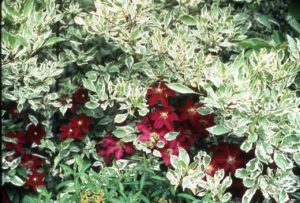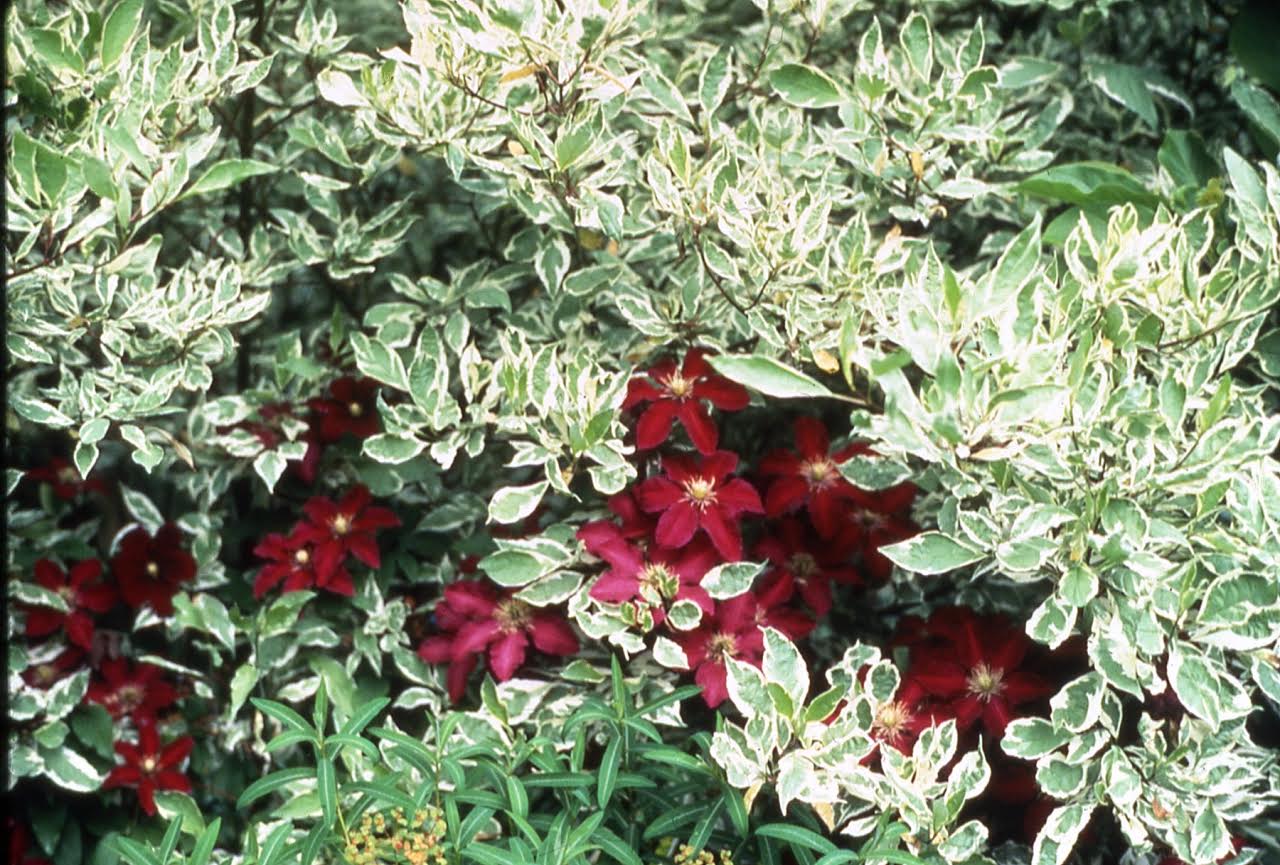
Be-A-Better-Gardener – Growing up
 Growing up: a clematis clambering up a dogwood (Cornus alba ‘Elegantissima’)
Growing up: a clematis clambering up a dogwood (Cornus alba ‘Elegantissima’)
By Thomas Christopher
In my personal life, I have found growing up to be not nearly as much fun as I had expected. Yes, I can now stay up as late as I want and watch whatever I want on television, but who really wants to stay up half the night watching late shows when you know you have to be up in the morning to earn money and pay the bills?
Growing up in the garden, however, is an entirely different matter.
In the garden, growing up is in part a way to fit more plants into a small space. The same vine that could sprawl over many square feet of ground space is confined to a trellis so that its sprawl is all vertical. What interests me more, though, about growing up, is the opportunity it provides to give another season of interest to otherwise by-passed areas of the landscape.
Consider, for example, what vines can do for spring bloomers such as forsythias, viburnums, rhododendrons, crab apples and cherry trees. These plants are glorious during their relatively short period of flowering, but fairly boring thereafter. Forsythias in particular, while most welcome during their early spring bloom, look weedy and unattractive during the rest of the growing season. Use them as living trellises for flowering vines, however, and the same bush can become a summer focal point. Or think how draping a clematis over a yew can transform a somewhat boring evergreen: the somber needles provide the perfect backdrop to emphasize the vivid colors of the blossoms.
There are certain rules for this sort of make-over. You must match the vine to the shrub in terms of vigor. A delicate climber looks insignificant when clinging to the lower branches of a billowing forsythia, whereas a more rampant climber, such as an sweet autumn clematis (Clematis paniculata) is likely to overwhelm a slower-growing yew. In general, you should avoid vines with dense foliage such as morning glories for this sort of application, as they are likely to smother their hosts. Clematises offer the kind of delicate foliage and colorful flowers that are ideal; climbing nasturtiums (Tropaeolum majus) are another excellent alternative. Climbing roses show off beautifully when scrambling up the branches of a crabapple or cherry. Variegated shrubs such as the green-and cream-leaved dogwoodCornus alba ‘Argenteo-marginata’ make a superb setting for flowering vines.
To make this marriage work, you must excavate a generous hole for the climber so that its roots have a chance to settle in before they must compete with those of the shrub. Locate the planting hole on the north or shady side of the shrub – the vine will grow toward the light and so thread itself through the shrub spontaneously. Give the young vine a head start, though, by directing it into the shrub and tie it to the shrub’s branches until it finds its own purchase. Be prepared to give some extra water and liquid fertilizer to the vine.
Some annual vines that will give you quick results include cardinal climber, (Ipomoea x multifida), which bears flowers as vivid as the bird its name commemorates; scarlet runner bean (Phaseolus coccineus) which can partner with larger more vigorous shrubs; and cardinal vine (Ipomoea quamoclit) another vigorous climber which has feathery foliage and bears trumpet-shaped flowers in shades of red, pink, or white. For an exotic touch, train a moonflower (Ipomoea alba) up a shrub by the terrace where you sit with your evening glass of wine – moonflowers open at dusk, the perfumed white trumpets attracting pale moths as their pollinators.
Thomas Christopher is the co-author of “Garden Revolution” (Timber Press, 2016) and is a volunteer at Berkshire Botanical Garden. berkshirebotanical.org
Be-a-Better-Gardener is a community service of Berkshire Botanical Garden, one of the nation’s oldest botanical gardens in Stockbridge, MA. Its mission to provide knowledge of gardening and the environment through 25 display gardens and a diverse range of classes informs and inspires thousands of students and visitors on horticultural topics every year. Thomas Christopher is the co-author of Garden Revolution (Timber press, 2016) and is a volunteer at Berkshire Botanical Garden. berkshirebotanical.org.


